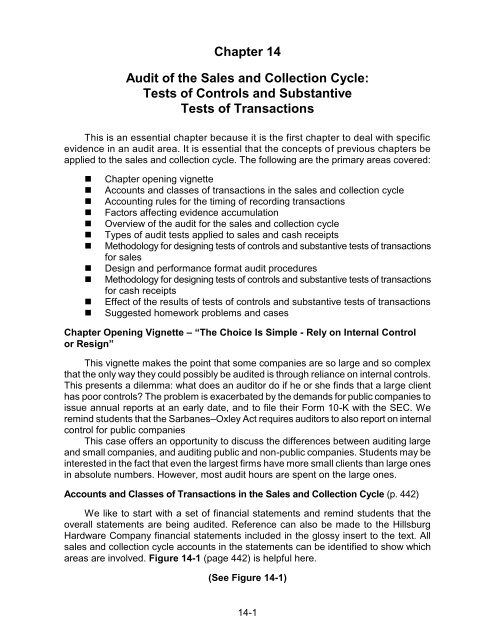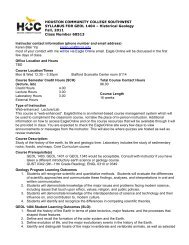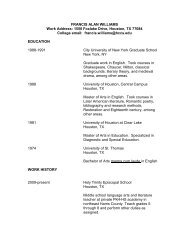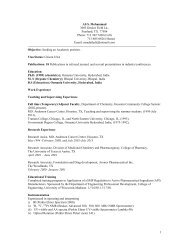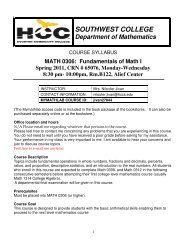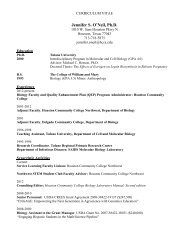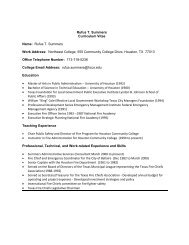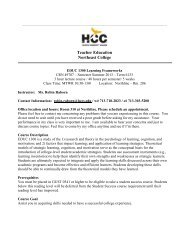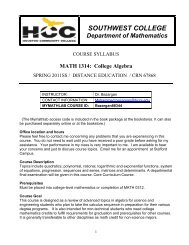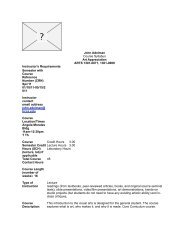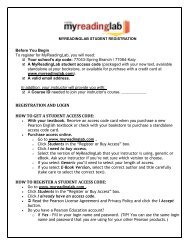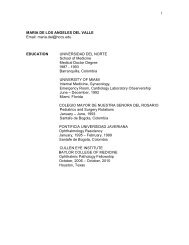Chapter 14 Audit of the Sales and Collection Cycle - HCC Learning ...
Chapter 14 Audit of the Sales and Collection Cycle - HCC Learning ...
Chapter 14 Audit of the Sales and Collection Cycle - HCC Learning ...
You also want an ePaper? Increase the reach of your titles
YUMPU automatically turns print PDFs into web optimized ePapers that Google loves.
<strong>Chapter</strong> <strong>14</strong><strong>Audit</strong> <strong>of</strong> <strong>the</strong> <strong>Sales</strong> <strong>and</strong> <strong>Collection</strong> <strong>Cycle</strong>:Tests <strong>of</strong> Controls <strong>and</strong> SubstantiveTests <strong>of</strong> TransactionsThis is an essential chapter because it is <strong>the</strong> first chapter to deal with specificevidence in an audit area. It is essential that <strong>the</strong> concepts <strong>of</strong> previous chapters beapplied to <strong>the</strong> sales <strong>and</strong> collection cycle. The following are <strong>the</strong> primary areas covered:• <strong>Chapter</strong> opening vignette• Accounts <strong>and</strong> classes <strong>of</strong> transactions in <strong>the</strong> sales <strong>and</strong> collection cycle• Accounting rules for <strong>the</strong> timing <strong>of</strong> recording transactions• Factors affecting evidence accumulation• Overview <strong>of</strong> <strong>the</strong> audit for <strong>the</strong> sales <strong>and</strong> collection cycle• Types <strong>of</strong> audit tests applied to sales <strong>and</strong> cash receipts• Methodology for designing tests <strong>of</strong> controls <strong>and</strong> substantive tests <strong>of</strong> transactionsfor sales• Design <strong>and</strong> performance format audit procedures• Methodology for designing tests <strong>of</strong> controls <strong>and</strong> substantive tests <strong>of</strong> transactionsfor cash receipts• Effect <strong>of</strong> <strong>the</strong> results <strong>of</strong> tests <strong>of</strong> controls <strong>and</strong> substantive tests <strong>of</strong> transactions• Suggested homework problems <strong>and</strong> cases<strong>Chapter</strong> Opening Vignette – “The Choice Is Simple - Rely on Internal Controlor Resign”This vignette makes <strong>the</strong> point that some companies are so large <strong>and</strong> so complexthat <strong>the</strong> only way <strong>the</strong>y could possibly be audited is through reliance on internal controls.This presents a dilemma: what does an auditor do if he or she finds that a large clienthas poor controls? The problem is exacerbated by <strong>the</strong> dem<strong>and</strong>s for public companies toissue annual reports at an early date, <strong>and</strong> to file <strong>the</strong>ir Form 10-K with <strong>the</strong> SEC. Weremind students that <strong>the</strong> Sarbanes–Oxley Act requires auditors to also report on internalcontrol for public companiesThis case <strong>of</strong>fers an opportunity to discuss <strong>the</strong> differences between auditing large<strong>and</strong> small companies, <strong>and</strong> auditing public <strong>and</strong> non-public companies. Students may beinterested in <strong>the</strong> fact that even <strong>the</strong> largest firms have more small clients than large onesin absolute numbers. However, most audit hours are spent on <strong>the</strong> large ones.Accounts <strong>and</strong> Classes <strong>of</strong> Transactions in <strong>the</strong> <strong>Sales</strong> <strong>and</strong> <strong>Collection</strong> <strong>Cycle</strong> (p. 442)We like to start with a set <strong>of</strong> financial statements <strong>and</strong> remind students that <strong>the</strong>overall statements are being audited. Reference can also be made to <strong>the</strong> HillsburgHardware Company financial statements included in <strong>the</strong> glossy insert to <strong>the</strong> text. Allsales <strong>and</strong> collection cycle accounts in <strong>the</strong> statements can be identified to show whichareas are involved. Figure <strong>14</strong>-1 (page 442) is helpful here.(See Figure <strong>14</strong>-1)<strong>14</strong>-1
Next, we find it useful to talk about <strong>the</strong> relationship between <strong>the</strong> financial statements,documents, <strong>and</strong> records.It is important that students thoroughly underst<strong>and</strong> how <strong>the</strong> information gets into <strong>the</strong>financial statements, <strong>the</strong> nature <strong>and</strong> purpose <strong>of</strong> journals, master files, <strong>and</strong> documentsaffecting <strong>the</strong> cycle. It is difficult to teach <strong>the</strong> material without actually seeing documents<strong>and</strong> records. The amount <strong>of</strong> time you need to spend depends on <strong>the</strong> students' backgroundin systems. We go through T-<strong>14</strong>-1 to help students underst<strong>and</strong> <strong>the</strong> relationship in <strong>the</strong>audit <strong>of</strong> sales <strong>and</strong> cash receipts.(See T-<strong>14</strong>-1)At <strong>the</strong> same time documents <strong>and</strong> records are discussed, <strong>the</strong> business functions in<strong>the</strong> cycle can be reviewed (page 443). Ask students to explain how <strong>the</strong> transactions foreach business function discussed in <strong>the</strong> early part <strong>of</strong> <strong>Chapter</strong> <strong>14</strong> affect <strong>the</strong> balances in<strong>the</strong> statements, <strong>and</strong> how <strong>the</strong>y are recorded so that <strong>the</strong>y are properly reflected. Table<strong>14</strong>-1 (page 444) is an excellent summary <strong>of</strong> <strong>the</strong> classes <strong>of</strong> transactions, accounts,business functions, <strong>and</strong> related documents <strong>and</strong> records in <strong>the</strong> sales <strong>and</strong> collection cycle.(See Table <strong>14</strong>-1)Accounting Rules for <strong>the</strong> Timing <strong>of</strong> Recording TransactionsIt is important that students underst<strong>and</strong> <strong>the</strong> "key point" for recording each type <strong>of</strong>transaction in <strong>the</strong> cycle.(See T-<strong>14</strong>-2)Factors Affecting Evidence AccumulationWe try to relate <strong>the</strong> material from early chapters to this cycle.• Four audit evidence decisions that must be made in <strong>the</strong> cycle (<strong>Chapter</strong> 7).• Acceptable audit risk (<strong>Chapter</strong> 9).• Expectation <strong>of</strong> misstatements for each account (<strong>Chapter</strong> 9). We emphasizeinternal control, materiality <strong>of</strong> accounts receivable, sales returns <strong>and</strong> allowances,bad debts, <strong>and</strong> results <strong>of</strong> prior year tests as being especially significant.• Underst<strong>and</strong>ing internal control <strong>and</strong> assessing control risk (<strong>Chapter</strong> 10).• Scope restrictions by <strong>the</strong> client or conditions (<strong>Chapter</strong> 3).• Reliability <strong>of</strong> confirmations (<strong>Chapter</strong> 7).(See T-<strong>14</strong>-3)Overview <strong>of</strong> <strong>the</strong> <strong>Audit</strong> for <strong>the</strong> <strong>Sales</strong> <strong>and</strong> <strong>Collection</strong> <strong>Cycle</strong>Before we get into <strong>the</strong> details <strong>of</strong> <strong>the</strong> audit, we go over <strong>the</strong> approach in Figure 10-11(page 320), applied to sales <strong>and</strong> cash receipts. We want students to underst<strong>and</strong> thatthis approach must be applied to each cycle. Also refer students to Figure <strong>14</strong>-2 (page448) <strong>and</strong> make sure students underst<strong>and</strong> <strong>the</strong> decision process.(See Figures 10-11 <strong>and</strong> <strong>14</strong>-2)<strong>14</strong>-2
Types <strong>of</strong> <strong>Audit</strong> Tests Applied to <strong>Sales</strong> <strong>and</strong> Cash ReceiptsIt is worthwhile to review <strong>the</strong> types <strong>of</strong> audit tests used in conducting <strong>the</strong> audit <strong>and</strong>discuss <strong>the</strong>m briefly for sales <strong>and</strong> cash receipts.(See T-<strong>14</strong>-4)Ask students to give examples <strong>of</strong> each type <strong>of</strong> tests for sales <strong>and</strong> cash receipts. It isuseful to refer to Figure 13-1 (page 403) as this discussion takes place.(See Figure 13-1)Methodology for Designing Tests <strong>of</strong> Controls <strong>and</strong> Substantive Tests <strong>of</strong>Transactions for <strong>Sales</strong> (page 448)We are now ready to review Table <strong>14</strong>-2 (pages 452-453).• Ask students why transaction-related audit objectives are used to develop <strong>the</strong>audit program.• Discuss <strong>the</strong> need to, <strong>and</strong> how to convert <strong>the</strong> general transaction-related auditobjectives to those used in column 1 <strong>of</strong> Table <strong>14</strong>-2.• Remind students that <strong>the</strong>re are four audit evidence decisions. Only auditprocedures are studied in this chapter.• Select two transaction-related audit objectives <strong>and</strong> go over <strong>the</strong>m in detail,covering columns 1-5. The important thing is to emphasize how <strong>the</strong> columnsrelate to each o<strong>the</strong>r (see top <strong>of</strong> next page).1. Transaction-related audit objectives - all four o<strong>the</strong>r columns are tied to<strong>the</strong> objectives.2. Key internal controls - relate to objectives.3. Common tests <strong>of</strong> controls - relate to key controls.4. Deficiencies - relate to objectives <strong>and</strong> indicate an absence <strong>of</strong> controls.5. Common substantive tests <strong>of</strong> transactions - relate to objectives.(See T-<strong>14</strong>-5)• Ask students to explain <strong>the</strong> effect on tests <strong>of</strong> controls <strong>and</strong> substantive tests <strong>of</strong>eliminating certain specific controls in Table <strong>14</strong>-2.• Ask students to explain <strong>the</strong> difference between occurrence <strong>and</strong> completenessfor sales. Figure <strong>14</strong>-4 (page 455) is a helpful illustration here.(See Figure <strong>14</strong>-4)• Ask students why certain procedures on Table <strong>14</strong>-2 are included in more thanone place.• Go over Problem <strong>14</strong>-25.Design <strong>and</strong> Performance Format <strong>Audit</strong> Procedures (page 458)Distinguish between a design <strong>and</strong> a performance format audit program, <strong>and</strong> explainwhy each is important. It is useful to combine several <strong>of</strong> <strong>the</strong> procedures in Table <strong>14</strong>-2 toshow how it should be done.<strong>14</strong>-3
Refer students to Table <strong>14</strong>-2 (pages 452-453), Table <strong>14</strong>-3 (page 461), <strong>and</strong> Figure<strong>14</strong>-6 (page 462) to illustrate going from a design to a performance format. We askstudents to trace a procedure in each direction. Ask <strong>the</strong> students which format is donefirst by <strong>the</strong> auditor <strong>and</strong> which format is used by <strong>the</strong> auditor in <strong>the</strong> field.(See Tables <strong>14</strong>-2 <strong>and</strong> <strong>14</strong>-3, Figure <strong>14</strong>-6)Methodology for Designing Tests <strong>of</strong> Controls <strong>and</strong> Substantive Tests <strong>of</strong>Transactions for Cash Receipts (page 459)We spend little time covering cash receipts except to emphasize:• The objectives <strong>and</strong> concepts are identical to those covered in sales.• The potential for <strong>the</strong>ft in cash receipts <strong>and</strong> <strong>the</strong> importance <strong>of</strong> <strong>the</strong> prelisting.• The relationship <strong>of</strong> sales <strong>and</strong> cash receipts, <strong>and</strong> why <strong>the</strong>y are a part <strong>of</strong> <strong>the</strong> samecycle.• Certain objectives are more important for cash receipts than sales, <strong>and</strong> o<strong>the</strong>rsare less important. It is useful to discuss which ones are important <strong>and</strong> why.• Define <strong>and</strong> explain <strong>the</strong> meaning <strong>of</strong> a pro<strong>of</strong> <strong>of</strong> cash receipts <strong>and</strong> its importanceas an audit test.• Define <strong>and</strong> explain lapping.Effect <strong>of</strong> Results <strong>of</strong> Tests <strong>of</strong> Controls <strong>and</strong> Substantive Tests <strong>of</strong> Transactions(page 464)It is important to remind students that only tests <strong>of</strong> controls <strong>and</strong> substantive tests <strong>of</strong>transactions audit procedures have been discussed, not sample size, or items to select.Also discuss, again, <strong>the</strong> relationship between tests <strong>of</strong> controls <strong>and</strong> substantive tests <strong>of</strong>transactions <strong>and</strong> <strong>the</strong> rest <strong>of</strong> <strong>the</strong> audit.Figure <strong>14</strong>-7 (page 465) provides a good summary <strong>of</strong> <strong>the</strong> chapter material. This figuresummarizes <strong>the</strong> major accounts in <strong>the</strong> sales <strong>and</strong> collection cycle, how <strong>the</strong> types <strong>of</strong> audittests are used to audit <strong>the</strong>se accounts, <strong>and</strong> how <strong>the</strong> audit risk model relates to <strong>the</strong> audit<strong>of</strong> <strong>the</strong> sales <strong>and</strong> collection cycle.(See Figure <strong>14</strong>-7)Suggested Homework Problems <strong>and</strong> CasesTo complete <strong>the</strong> coverage <strong>of</strong> <strong>the</strong> material in this chapter, we suggest assigningProblem <strong>14</strong>-31 or Case <strong>14</strong>-33. We suggest using Part IV <strong>of</strong> <strong>the</strong> Pinnacle ManufacturingIntegrated Case (Case <strong>14</strong>-34) if you assigned Part III (Case 10-43) earlier.<strong>14</strong>-4
<strong>14</strong>-5CHAPTER <strong>14</strong>CROSS-REFERENCE OF LEARNING OBJECTIVES AND PROBLEM MATERIAL<strong>Learning</strong> ObjectivesReviewQuestionsMultipleChoiceQuestionsDiscussionQuestions<strong>and</strong> ProblemsACL Problem<strong>and</strong> Cases<strong>14</strong>-1 Identify <strong>the</strong> accounts <strong>and</strong> <strong>the</strong> classes <strong>of</strong> transactionsin <strong>the</strong> sales <strong>and</strong> collection cycle.<strong>14</strong>-23<strong>14</strong>-2 Describe <strong>the</strong> business functions <strong>and</strong> <strong>the</strong> relateddocuments <strong>and</strong> records in <strong>the</strong> sales <strong>and</strong> collectioncycle.<strong>14</strong>-1, <strong>14</strong>-2,<strong>14</strong>-3, <strong>14</strong>-4<strong>14</strong>-24, <strong>14</strong>-27<strong>14</strong>-3 Underst<strong>and</strong> internal control, <strong>and</strong> design <strong>and</strong> performtests <strong>of</strong> controls <strong>and</strong> substantive tests <strong>of</strong>transactions for sales.<strong>14</strong>-5, <strong>14</strong>-6,<strong>14</strong>-7, <strong>14</strong>-8,<strong>14</strong>-9, <strong>14</strong>-10,<strong>14</strong>-18, <strong>14</strong>-19,<strong>14</strong>-20<strong>14</strong>-21, <strong>14</strong>-22,<strong>14</strong>-23<strong>14</strong>-24, <strong>14</strong>-25,<strong>14</strong>-26, <strong>14</strong>-27,<strong>14</strong>-28, <strong>14</strong>-29,<strong>14</strong>-31, <strong>14</strong>-32<strong>14</strong>-33, <strong>14</strong>-34<strong>14</strong>-4 Apply <strong>the</strong> methodology for controls over salestransactions to controls over sales returns <strong>and</strong>allowances.<strong>14</strong>-11 <strong>14</strong>-21, <strong>14</strong>-22 <strong>14</strong>-24, <strong>14</strong>-25 <strong>14</strong>-35<strong>14</strong>-5 Underst<strong>and</strong> internal control, <strong>and</strong> design <strong>and</strong> performtests <strong>of</strong> controls <strong>and</strong> substantive tests <strong>of</strong>transactions for cash receipts.<strong>14</strong>-12, <strong>14</strong>-13,<strong>14</strong>-<strong>14</strong>, <strong>14</strong>-15,<strong>14</strong>-16, <strong>14</strong>-18,<strong>14</strong>-19<strong>14</strong>-21 <strong>14</strong>-24, <strong>14</strong>-25,<strong>14</strong>-28, <strong>14</strong>-30,<strong>14</strong>-31<strong>14</strong>-34, <strong>14</strong>-35<strong>14</strong>-6 Apply <strong>the</strong> methodology for controls over <strong>the</strong> sales<strong>and</strong> collection cycle to write-<strong>of</strong>fs <strong>of</strong> uncollectibleaccounts receivable.<strong>14</strong>-17 <strong>14</strong>-21
SOURCE OF INFORMATION FORTHE SALES AND COLLECTION CYCLE<strong>Sales</strong> <strong>and</strong><strong>Collection</strong> <strong>Cycle</strong>Account Balancesin <strong>the</strong> FinancialStatementsEXAMPLES <strong>Sales</strong> Accts. Rec. Cash <strong>Sales</strong> R & AMaster FileAffectingAccountsin <strong>the</strong>General Ledger<strong>Sales</strong> <strong>and</strong><strong>Collection</strong> <strong>Cycle</strong>Accounts in <strong>the</strong>General Ledger(Figure <strong>14</strong>-1)Journals AffectingAccounts in <strong>the</strong>General Ledger Same as above <strong>Sales</strong> Journal Cash ReceiptsJournalEXAMPLE AccountsReceivableMaster FileTransactionsRecorded in <strong>the</strong>Journals <strong>and</strong>Master Files Cash <strong>Sales</strong> Credit <strong>Sales</strong> <strong>Sales</strong> Returns Cash ReceiptsDocuments Relatedto <strong>the</strong> Transactions <strong>Sales</strong> Invoices Ship. Documents RemittanceAdvicesT-<strong>14</strong>-1
KEY POINTS FOR RECOGNITIONOF SALES AND COLLECTIONCYCLE TRANSACTIONS<strong>Sales</strong>:Cash Receipts:<strong>Sales</strong> Returns<strong>and</strong> Allowances:Bad Debts:Write-Off <strong>of</strong>UncollectiblesUsually at <strong>the</strong> date <strong>of</strong> shipment;exception - earlier, when titlepasses before <strong>the</strong> date <strong>of</strong>shipmentDate <strong>of</strong> receipt by <strong>the</strong> companyIn <strong>the</strong> same period as <strong>the</strong>period in which <strong>the</strong> sale isrecordedPeriodically; usually as apercent <strong>of</strong> sales for <strong>the</strong> periodwith adjustment at year-endWhen <strong>the</strong> receivable is nolonger considered to becollectibleT-<strong>14</strong>-2
FOUR AUDIT EVIDENCE DECISIONSSALESCASHRECEIPTS<strong>Audit</strong> Procedures Table <strong>14</strong>-2 Table <strong>14</strong>-3Sample Size <strong>Chapter</strong> 15 <strong>Chapter</strong> 15Items to Select <strong>Chapter</strong> 15 <strong>Chapter</strong> 15Timing <strong>Chapter</strong>s 6 & 13 <strong>Chapter</strong>s 6 & 13T-<strong>14</strong>-3
TYPES OF AUDIT TESTSTYPES OFAUDIT TESTSACHIEVED LEVELOF ASSURANCETests <strong>of</strong> Controls(including Proceduresto Obtain anUnderst<strong>and</strong>ing <strong>of</strong> I/C)Substantive Tests <strong>of</strong>TransactionsAnalytical ProceduresTests <strong>of</strong> Details<strong>of</strong> BalancesTotalT-<strong>14</strong>-4
RELATIONSHIPS IN TABLE <strong>14</strong>-2Transaction-Related<strong>Audit</strong>ObjectivesKeyInternalControlsCommonTests <strong>of</strong>ControlsCommonSubstantiveTests <strong>of</strong>TransactionsSubstantive procedures depend on key internalcontrols, deficiencies in internal control, materiality<strong>of</strong> sales, etc.T-<strong>14</strong>-5


